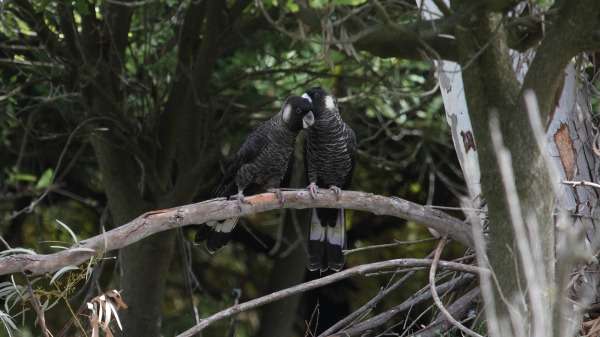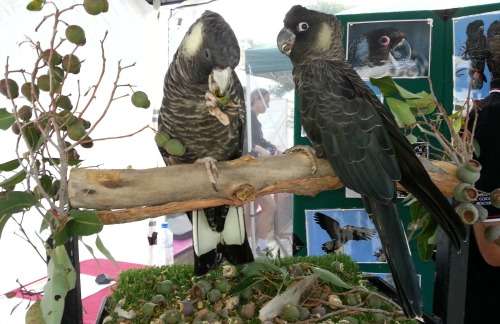Study bird ‘Purple F’ preening a young male in a Macadamia orchard in Baldivis. The tip of the aerial from her tracking device protrudes from the end of her tail feathers. Credit: Christine Groom
A study tracking the movements of WA's endangered Carnaby's black-cockatoo (Calyptorhynchus latirostris) has discovered that not only will the birds adapt to urban environments but they also use non-native vegetation for feeding and roosting.
These findings open the door for people living in urban areas to contribute to the survival of the iconic species by planting trees that can act as roosting sites and provide food.
The cockatoo is considered a threatened species partly because of increased urban expansion.
The birds breed in the Wheatbelt and migrate to the Swan Coastal Plain between January and September.
As urban sprawl increases across the Swan coastal areas, the native home of the Carnaby's black-cockatoo is under threat.
University of Western Australia researcher and study author Christine Groom says Argos tracking devices fixed to the tail feathers of 23 cockatoos over a two-year period, allowed her to track the flight patterns, eating habits and roosting practices of the birds.
She says the data identified 18 key roosting sites across the Perth metropolitan area.
"One thing that was particular interesting is that nearly all of these sites are trees that are not locally native, such as lemon-scented gums (Corymbia citriodora) and Pine trees (Pinaceae)," she says.
"That's particularly significant because it means the cockatoos have the ability to adapt to living in the urban areas and it means people living in Perth can get involved in the conservation efforts by planting trees for these birds to roost in," she says.
A Baudin's (Calyptorhynchus baudinii) and Carnaby's cockatoo at the 2014 Perth Science Festival. Credit: N Brant
The birds used in the study were all rehabilitated animals and the study also found they were able to adapt back into the natural environment.
"The first thing I had to establish was that the rehabilitated birds were surviving and the study demonstrated that their survival was similar to that of the wild birds," she says.
"The observations showed they were meeting up with wild birds and flying in flocks.
"None of them had to be returned to care for any reason, showing that our ability to rehabilitate injured birds is very good," she says.
Ms Groom says the study also demonstrated the cockatoos ate non-native vegetation such as nuts from pecan, macadamia and almond trees and seeds from the Tipuana (Dalbergieae) and liquid amber (Liquidambar styraciflua) trees.
"Banksia's are their main traditional food source and while we don't yet understand the nutritional implications of these non-natives, it shows they use non-native vegetation," she says.
More information: "Attachment and performance of Argos satellite tracking devices fitted to black cockatoos (Calyptorhynchus spp.)" Wildlife Research 41(7) 571-583 dx.doi.org/10.1071/WR14138
Provided by Science Network WA

























